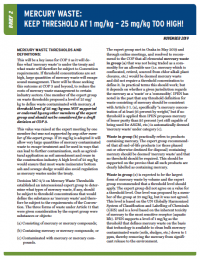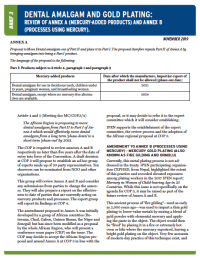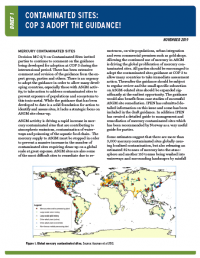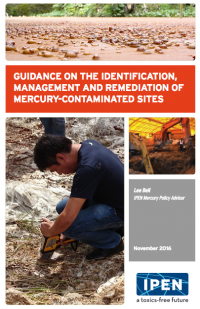Information Materials
20 November, 2019
Mercury Contaminated Sites Guidance Posters
These posters list the steps to take when trying to identify a mercury contaminated site and address the problem.
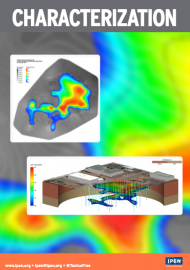
19 November, 2019
IPEN Brief on Mercury Waste Thresholds and Definitions (русский, English, español, français, العربية)
Mercury waste thresholds and definitions will be key issues for COP3 as they will define what ‘mercury waste’ is under the treaty and what waste will therefore be subject to Convention requirements. If threshold concentrations are set high, large quantities of mercury waste will escape sound management.
IPEN believes that concentrations should be set at a maximum of 1 mg/kg in order to be health and environment protective.
Learn why, as well as what types of mercury waste should be subject to threshold concentrations, in IPEN’s brief here.
17 November, 2019
IPEN Brief on Dental Amalgam and Gold Plating (Review of Annex A (mercury-added products) and Annex B (processes using mercury) (English, español, français, العربية)
The Conference of the Parties (COP) is required to review annexes A and B no later than five years after the date of entry into force of the Convention. A draft decision at COP3 will propose to establish an ad hoc group of experts made up of 20 party representatives and 10 observers nominated from NGO and other organizations. This group will review Annex A and B and consider any submissions from parties to change the annexes. IPEN supports the establishment of the expert committee and the review process.
Amendment to Annex A: The African Region is proposing to move dental amalgam from Part II to Part I of Annex A, which would effectively move dental amalgam from a long term ‘phase-down’ to a short term ‘phase-out’ by 2021. IPEN supports the adoption of the African regional proposal at COP 3.
Amendment to Annex B: The ancient process of “fire gilding” was used to impart a thin gold plating to lower-value metals by mixing a blend of gold powder with elemental mercury and applying the paste to the object. The object would then be “fired” by placing it in a fire or extremely hot oven or kiln where the mercury vaporized, leaving a bright gold plating on the object, but also potentially a significant exposure issue for workers and the public near plating facilities. IPEN supports the addition of fire gilding/mercury gold plating to Annex B of the mercury treaty as soon as possible to reduce the massive emissions and releases caused by this process.
For more details about these points, read the entire brief here.
16 November, 2019
IPEN Brief on Contaminated Sites (русский, English, español, français, العربية)
Decision MC-2/8 on Contaminated Sites invites parties to continue to comment on the guidance being developed for adoption at COP3 during the intersessional period. There has been extensive comment and revision of the guidance from the expert group, parties, and more. There is an urgency to adopt the guidance in order to allow many developing countries, especially those with ASGM activity, to take action to address contaminated sites to prevent exposure of populations and ecosystems to this toxic metal.
Parties should adopt the guidance at COP3!
Read the entire brief here.
15 November, 2019
Guidance on the Identification, Management and Remediation of Mercury-Contaminated Sites (русский, English, español, français, العربية)
Accompanying IPEN document: Frequently Asked Questions about Mercury Contaminated Sites
8 November, 2019
IPEN'S "QUICK VIEWS" ON THE MERCURY TREATY COP3 (русский, English, español, français, العربية)
This document presents IPEN's views about some issues that will be addressed at the 3rd Conference of the Parties, including open burning, effectiveness evaluation, review of Annexes A & B, waste thresholds, contaminated sites, and more.
Conference variant

